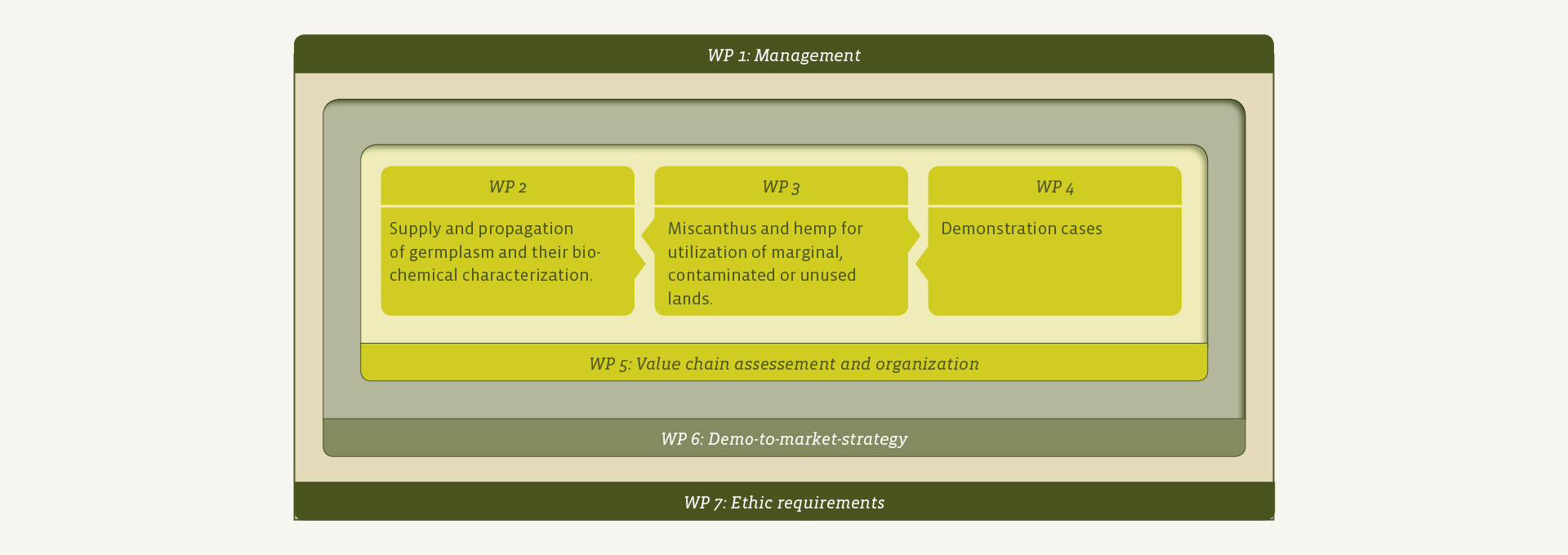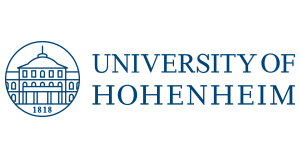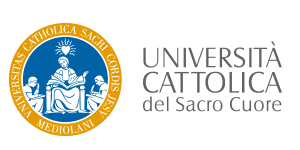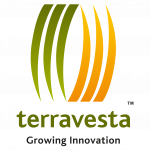GRACE
The BBI demonstration project “GRowing Advanced industrial Crops on marginal lands for biorEfineries” (GRACE) is a 15 million € project, which aims at optimizing various miscanthus and hemp value chains.
The consortium consists of 21 partners from universities, agricultural companies and industry. The project is coordinated by the University of Hohenheim in Stuttgart (Germany). It is primarily (12.3 million €) funded by the „Bio-based Industries Joint Undertaking“ (BBI JU), a public-private partnership between the European Union and “Bio-based Industries Consortium” (BIC). The private project partners are contributing the remaining 2.7 million €.
The goals of the project are to produce sustainable products with a strong market potential, to guarantee a reliable and affordable supply of sustainably produced biomass, and to better link biomass producers with the processing industry. In order to avoid competition with food and feed crops, miscanthus and hemp are cultivated on areas that have been polluted for example by heavy metals, or are unattractive for food production due to lower yields.
Work Packages


Coordinator University of Hohenheim
Founded in 1818 after devastating famines, the University of Hohenheim is the oldest university in Stuttgart. Traditionally it has been committed to developing innovative solutions for some of society’s most pressing problems. Today, the University of Hohenheim is the leading German university in agricultural research and food sciences. In addition, it has an excellent reputation in natural, social, business, economic, and communication sciences. The university places great importance on maintaining an international network with strong partners.
At the University of Hohenheim, there is a unique cooperation between the university’s three faculties in research and teaching in the field of the bioeconomy. The bioeconomy is about the economics of the future, with new products and new productions processes, made from raw materials derived from plants, animals or microorganisms.
The GRACE project is coordinated by the Department „Biobased Resources in the Bioeconomy“, which was founded in 2010 as part of the Institute of Crop Science within the Faculty of Agricultural Sciences. It is led by Prof. Dr. Iris Lewandowski. The Department’s research focuses on the contribution of biomass production and energy crops to a growing bioeconomy and to increased sustainability.
University of Hohenheim

Department: Biobased Resources in the Bioeconomy
Coordinators: Andreas Kiesel, Iris Lewandowski
Persons involved: Elena Magenau, Jan Weik, Jan Lask
Role: Coordinator, Leader WP 1 and 5
Department: Conversion Technology and Life Cycle Assessment of Renewable Resources
Persons involved: Andrea Kruse, Maciej Olszewski
Role: Leader Demo Case 3
Department: State Institute of Agricultural Engineering and Bioenergy
Persons involved: Andreas Lemmer, Johannes Krümpel, Muhammad Tahir Khan
Department: Hohenheim Research Center for Bioeconomy
Persons involved: Susanne Braun
Partners
Wageningen University

Wageningen University is the best university in the field of agricultural and food science, in research and education (rankings 2015 and 2016). The department of Plant Breeding conducts research in the field of genetics and breeding of food and biobased crops.
Persons involved: Luisa Trindade, Mohamad Al Hassan, Kasper van der Cruijsen
Role: Leader WP 2
INRA

INRA, with its 12000 employees, is the first institute for agronomic research in Europe and the second in the world. GRACE involves laboratories specialized in plant biology (“IJPB”) and soil science (“Ecosys”) in Versailles, and biomass transformation (“IATE”)in Montpellier.
Persons involved: Herman Höfte, Isabelle Lamy, Cecile Barron, Frédéric Mabille
Role: Leader WP 4
Aberythwyth University

Based in Aberystwyth University, the Energy Crops and Modelling group at IBERS (Institute of Biological, Environmental and Rural Sciences) plays a major role in developing Miscanthus as a commercial crop in addition to considering wider environmental impacts such as greenhouse gas exchange and water use efficiency.
Persons involved: John Clifton-Brown, Chris Ashman, Danny Awty-Carroll
Role: Leader WP 3
Università Cattolica del Sacro Cuore

UCSC is the largest Italian free academic Institution. The Field Crop Research group, within the Department of Sustainable Crop Production, studies issues related to sustainable soil management, biomass crops and ecophysiology of crops under abiotic stress.
Persons involved : Stefano Amaducci, Andrea Ferrarini, Enrico Martani, Blandinieres Henri, Giorgio Impollonia
University of Zagreb

University of Zagreb Faculty of Agriculture (FAZ) is the oldest and leading institution of higher education in the field of agriculture in Croatia. Department of Ag Technology, Storage and Transport is a leading centre for biomass research at FAZ, dealing with different aspects of biomass and biofuels’ production.
Persons involved: Vanja Jurisic, Mislav Kontek
Novamont S.p.A.

Novamont is the Italian world’s leading company in the sector of bioplastics and in the development of bioproducts obtained through the integration of chemistry and agriculture, by starting up biorefineries in the local areas and providing solutions for everyday life.
Persons Involved: Sara Guerrini, Cecilia Giardi
Role: Leader Demo Case 2 and 8
Mogu Srl

Mogu is a start-up that focuses on the use of mycelium-based technologies to produce sustainable bio-composite materials, following the principles of the circular economy. Mogu products are suitable for various applications such as housing materials and bio-design.
Persons involved: Stefano Babbini, Maria Garcia Torreiro
Role: Leader Demo Case 4
AVA Biochem BSL AG

AVA Biochem is a specialty chemicals company and produces the premium platform chemical 5-Hydroxymethylfurfural (5-HMF) from renewable biomass. The company delivers to the pharmaceutical, food and fine chemical industry as well as to research customers around the globe.
Persons involved: Dr. Stefan Krawielitzki, Gilbert Anderer
Addiplast SA

French family company created in 1986, Addiplast turnover is close to 20 million Euros per year; including 40% on export market. Addiplast is specialized in formulation and production of thermoplastic compounds including bio-resources or natural fibres filled compounds.
Persons involved: Guillaume Ales
Role: Leader Demo Case 5
INA d.d.

INA Group has the leading role in Croatian oil business and significant regional role in oil and gas exploration, processing and distribution of oil and oil derivatives. The oil is processed at two refineries, and distributed on 494 regional filling stations.
Persons involved: Ištuk Mladen, Slavica Rukavina, Boris Slijepčević
Role: Leader Demo Case 1
Indena SpA

Indena, a privately owned italian company, is a world leading society in the development and production of active priciple derived from plants, for use in the pharmaceutical and health-food industries.
Persons involved: Federico Peterlongo
Role: Leader Demo Case 10
Consorzio di Bonifica di Piacenza

Consorzio di Bonifica di Piacenza is an organization based on public law managed by Consortium members, which coordinate both public and private works devoted to drainage, irrigation, flood control, soil defence, protecting waters and environment.
Persons involved: Angela Zerga, Chiara Gemmati
Gießereitechnik Kuehn

Consultancy, cultivation and utilization of renewable raw materials. Development and construction of machines for the preparation and processing of renewable resources. Supply of fibre and pulp fractions from renewable raw materials for industrial material use and for research projects.
Persons involved: Uwe Kühn, Carmen Retzela
Role: Leader Demo Case 9
Gruppo Fibranova S.r.l.

Gruppo Fibranova S.r.l. collaborates with and advices farmers in hemp cultivation. Gruppo Fibranova organizes hemp harvest and processing into hemp fibre products and seperating of seeds for oil extraction.
Persons involved: Michele Agriesti, Fabrizio Sassetti
Miscanthusgroep

MiscanthusGroep is an association of farmers in the west of the Netherlands , working on improvement of growth and production of miscanthus. Together with clients we develop new value chains with products as concrete, composites and horsebedding.
Persons involved: Gertjan Petrie
Role: Leader Demo Case 7
Terravesta

Terravesta is the leading global Miscanthus specialist. The UK based company delivers a complete supply chain solution for producers of the crop and works with about 350 UK growers, to supply several markets, including large and small-scale heat and power generation.
Persons involved: William Cracroft-Eley, Jason Kam, Simon Calder
Role: Leader WP 3
Vandinter-Semo

Vandinter Semo, founded in 1914, is still a family owned company and a significant producer and processor of seed in the Netherlands and far beyond. Moreover, Vandinter Semo has built a unique reputation as a breeder of cruciferous vegetables with a high resistance against nematodes.
Persons involved: Bert-Jan van Dinter
NovaBiom

Since 2006, Novabiom is devoted to the development and the promotion of miscanthus in France and Europe. It is owned by 25 partners, 15 of which are farmers, all fully committed in our sustainable and meaningful projects. In addition Novabiom is strongly involved in R&D.
Persons involved: Emmanuel De Maupeou, Philip van der Pluijm
Johannes Furtlehner

Miscanthusfarm is a company specialized in the cultivation and the use of Miscanthus. Since 2005, we have developed Miscanthus plantations in various European countries. The company supplies and operates biomass heating plants in Austria and distributes other products from Miscanthus such as mulch material and horse bedding.
Persons involved: Johannes Furtlehner
Cluster SPRING

SPRING (Sustainable Processes and Resources for Innovation and National Growth) is the Italian Cluster of Green Chemistry. It brings together innovative realities active in the development of the green chemistry sector in order to reach a new economy (bioeconomy).
Persons involved: Mario Bonaccorso, Giulia Rognoni
Role: Leader WP 6
Funders
The GRACE project has received funding from the Bio-Based Industries Joint Undertaking (BBI JU) under the European Union’s Horizon 2020 research and innovation programme under grant agreement No 745012.
Bio based Industries Consortium

Bio based Industries Public-Private Parnership

European Union

Bio based Industries Consortium

Bio based Industries Public-Private Parnership

European Union

Publications
Overview is updated on a regular basis (Last: 31 Jan 2023).
- Clifton‐Brown, J., Hastings, A., Cossel, M. von, Murphy‐Bokern, D., McCalmont, J., Whittaker, J., . . . Kiesel, A. (2023). Perennial biomass cropping and use: shaping the policy ecosystem in European countries. GCB Bioenergy. Advance online publication. https://doi.org/10.1111/gcbb.13038
- Shepherd, A., Awty‐Carroll, D., Kam, J., Ashman, C., Magenau, E., Martani, E., . . . Hastings, A. (2023). Novel Miscanthus hybrids: Modelling productivity on marginal land in Europe using dynamics of canopy development determined by light interception. GCB Bioenergy. Advance online publication. https://doi.org/10.1111/gcbb.13029
- Magenau, E., Clifton‐Brown, J., Parry, C., Ashman, C., Awty‐Carroll, D., Ferrarini, A., . . . Kiesel, A. (2023). Spring emergence and canopy development strategies in miscanthus hybrids in Mediterranean, continental and maritime European climates. GCB Bioenergy. Advance online publication. https://doi.org/10.1111/gcbb.13035
- Blandinières, H., Croci, M., Impollonia, G., Marcone, A., Gay, A., Winters, A., . . . Amaducci, S. (2023). Multi-environment assessment of a yellow hemp (Cannabis sativa L.) cultivar’s eco-physiology and productivity under varying levels of nitrogen fertilisation. Industrial Crops and Products, 195, 116360. https://doi.org/10.1016/j.indcrop.2023.116360
- Weik, J., Lask, J., Petig, E., Seeger, S., Marting Vidaurre, N., Wagner, M., . . . Angenendt, E. (2022). Implications of large‐scale miscanthus cultivation in water protection areas: A Life Cycle Assessment with model coupling for improved policy support. GCB Bioenergy, 14(11), 1162–1182. https://doi.org/10.1111/gcbb.12994
- Khan, M. T., Huelsemann, B., Krümpel, J., Wüst, D., Oechsner, H., & Lemmer, A. (2022). Biochemical Methane Potential of a Biorefinery’s Process-Wastewater and its Components at Different Concentrations and Temperatures. Fermentation, 8(10), 476. https://doi.org/10.3390/fermentation8100476
- Marting Vidaurre, N. A., Lewandowski, I., & Lask, J. (2022). Identifying methodological challenges in the social risk assessment of cellulosic ethanol value chains. Journal of Industrial Ecology, 26(4), 1233–1246. https://doi.org/10.1111/jiec.13287
- Blandinières, H., & Amaducci, S. (2022). Adapting the cultivation of industrial hemp (Cannabis sativa L.) to marginal lands: A review. GCB Bioenergy, 14(9), 1004–1022. https://doi.org/10.1111/gcbb.12979
- Impollonia, G., Croci, M., Blandinières, H., Marcone, A., & Amaducci, S. (2022). Comparison of PROSAIL Model Inversion Methods for Estimating Leaf Chlorophyll Content and LAI Using UAV Imagery for Hemp Phenotyping. Remote Sensing, 14(22), 5801. https://doi.org/10.3390/rs14225801
- Wu, P.-C., Ashman, C., Awty‐Carroll, D., Robson, P., & Clifton‐Brown, J. (2022). Optimizing seed‐based Miscanthus plug plant production with supplemental heat and light, compost type and volume. GCB Bioenergy, 14(6), 624–638. https://doi.org/10.1111/gcbb.12920
- Awty‐Carroll, D., Magenau, E., Al Hassan, M., Martani, E., Kontek, M., van der Pluijm, P., . . . Clifton-Brown, J. (2022). Yield performance of fourteen novel inter- and intra-species Miscanthus hybrids across Europe. GCB Bioenergy. Advance online publication. https://doi.org/10.1111/gcbb.13026
- Magenau, E., Clifton‐Brown, J., Awty‐Carroll, D., Ashman, C., Ferrarini, A., Kontek, M., . . . Kiesel, A. (2022). Site impacts nutrient translocation efficiency in intraspecies and interspecies miscanthus hybrids on marginal lands. GCB Bioenergy, 14(9), 1035–1054. https://doi.org/10.1111/gcbb.12985
- Impollonia, G., Croci, M., Ferrarini, A., Brook, J., Martani, E., Blandinières, H., . . . Amaducci, S. (2022). UAV Remote Sensing for High-Throughput Phenotyping and for Yield Prediction of Miscanthus by Machine Learning Techniques. Remote Sensing, 14(12), 2927. https://doi.org/10.3390/rs14122927
- Lazarević, B., Kontek, M., Carović‐Stanko, K., Clifton‐Brown, J., Al Hassan, M., Trindade, L. M., & Jurišić, V. (2022). Multispectral image analysis detects differences in drought responses in novel seeded Miscanthus sinensis hybrids. GCB Bioenergy, 14(11), 1219–1234. https://doi.org/10.1111/gcbb.12999
- Impollonia, G., Croci, M., Martani, E., Ferrarini, A., Kam, J., Trindade, L. M., . . . Amaducci, S. (2022). Moisture content estimation and senescence phenotyping of novel Miscanthus hybrids combining UAV‐based remote sensing and machine learning. GCB Bioenergy, 14(6), 639–656. https://doi.org/10.1111/gcbb.12930
- Al Hassan, M., van der Cruijsen, K., Dees, D., Dolstra, O., & Trindade, L. M. (2022). Investigating applied drought in Miscanthus sinensis ; sensitivity, response mechanisms, and subsequent recovery. GCB Bioenergy, 14(7), 756–775. https://doi.org/10.1111/gcbb.12941
- Świątek, K., Olszewski, M. P., & Kruse, A. (2022). Continuous synthesis of 5- hydroxymethylfurfural from biomass in on- farm biorefinery. GCB Bioenergy, 14869, 681-693. https://doi.org/10.1111/gcbb.12938
- Götz, M., Rudi, A., Heck, R., Schultmann, F., & Kruse, A. (2022). Processing Miscanthus to high‐value chemicals: A techno‐economic analysis based on process simulation. GCB Bioenergy, 14(4), 447–462. https://doi.org/10.1111/gcbb.12923
- Khan, M. T., Krümpel, J., Wüst, D., & Lemmer, A. (2021). Anaerobic Degradation of Individual Components from 5-Hydroxymethylfurfural Process-Wastewater in Continuously Operated Fixed Bed Reactors. Processes, 9(4), 677. https://doi.org/10.3390/pr9040677
- Lask, J., Kam, J., Weik, J., Kiesel, A., Wagner, M., & Lewandowski, I. (2021). A parsimonious model for calculating the greenhouse gas emissions of miscanthus cultivation using current commercial practice in the United Kingdom. GCB Bioenergy, 13(7), 1087–1098. https://doi.org/10.1111/gcbb.12840
- Lask, J., Rukavina, S., Zorić, I., Kam, J., Kiesel, A., Lewandowski, I., & Wagner, M. (2021). Lignocellulosic ethanol production combined with CCS—A study of GHG reductions and potential environmental trade‐offs. GCB Bioenergy, 13(2), 336–347. https://doi.org/10.1111/gcbb.12781
- Magenau, E., Kiesel, A., Clifton‐Brown, J., & Lewandowski, I. (2021). Influence of cutting height on biomass yield and quality of miscanthus genotypes. GCB Bioenergy, 13(10), 1675–1689. https://doi.org/10.1111/gcbb.12881
- Schulte, M., Lewandowski, I., Pude, R., & Wagner, M. (2021). Comparative life cycle assessment of bio‐based insulation materials: Environmental and economic performances. GCB Bioenergy, 13(6), 979–998. https://doi.org/10.1111/gcbb.12825
- Van der Cruijsen, K., Al Hassan, M., van Erven, G., Dolstra, O., & Trindade, L. M. (2021). Breeding Targets to Improve Biomass Quality in Miscanthus. Molecules (Basel, Switzerland), 26(2). https://doi.org/10.3390/molecules26020254
- Lask, J., Magenau, E., Ferrarini, A., Kiesel, A., Wagner, M., & Lewandowski, I. (2020). Perennial rhizomatous grasses: Can they really increase species richness and abundance in arable land?—A meta‐analysis. GCB Bioenergy, 12(11), 968–978. https://doi.org/10.1111/gcbb.12750
- Lask, J., Martínez Guajardo, A., Weik, J., Cossel, M., Lewandowski, I., & Wagner, M. (2020). Comparative environmental and economic life cycle assessment of biogas production from perennial wild plant mixtures and maize (Zea mays L.) in southwest Germany. GCB Bioenergy, 12(8), 571–585. https://doi.org/10.1111/gcbb.12715
- Riglet, L., Rozier, F., Kodera, C., Bovio, S., Sechet, J., Fobis-Loisy, I., & Gaude, T. (2020). Katanin-dependent mechanical properties of the stigmatic cell wall mediate the pollen tube path in Arabidopsis. ELife, 9. https://doi.org/10.7554/eLife.57282
- Świątek, K., Gaag, S., Klier, A., Kruse, A., Sauer, J., & Steinbach, D. (2020). Acid Hydrolysis of Lignocellulosic Biomass: Sugars and Furfurals Formation. Catalysts, 10(4), 437. https://doi.org/10.3390/catal10040437
- Clifton-Brown, J., Harfouche, A., Casler, M. D., Dylan Jones, H., Macalpine, W. J., Murphy-Bokern, D., . . . Lewandowski, I. (2019). Breeding progress and preparedness for mass-scale deployment of perennial lignocellulosic biomass crops switchgrass, miscanthus, willow and poplar. GCB Bioenergy, 11(1), 118–151. https://doi.org/10.1111/gcbb.12566
- Clifton-Brown, J., Schwarz, K.‑U., Awty-Carroll, D., Iurato, A., Meyer, H., Greef, J., . . . Robson, P. (2019). Breeding Strategies to Improve Miscanthus as a Sustainable Source of Biomass for Bioenergy and Biorenewable Products. Agronomy, 9(11), 673. https://doi.org/10.3390/agronomy9110673
- Wagner, M., Kamp, L., Graeff-Hönninger, S., & Lewandowski, I. (2019). Environmental and Economic Performance of Yacon (Smallanthus sonchifolius) Cultivated for Fructooligosaccharide Production. Sustainability, 11(17), 4581. https://doi.org/10.3390/su11174581
- Wagner, M., Mangold, A., Lask, J., Petig, E., Kiesel, A., & Lewandowski, I. (2019). Economic and environmental performance of miscanthus cultivated on marginal land for biogas production. GCB Bioenergy, 11(1), 34–49. https://doi.org/10.1111/gcbb.12567


